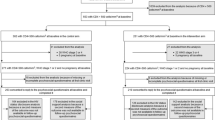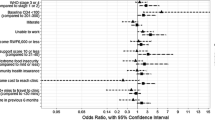Abstract
From December 2005 to April 2007, we enrolled 60 adults starting antiretroviral therapy (ART) in Lima, Peru to receive community-based accompaniment with supervised antiretrovirals (CASA), consisting of 12 months of DOT-HAART, as well as microfinance assistance and/or psychosocial support group according to individuals’ need. We matched 60 controls from a neighboring district, and assessed final clinical and psychosocial outcomes at 24 months. CASA support was associated with higher rates of virologic suppression and lower mortality. A comprehensive, tailored adherence intervention in the form of community-based DOT-HAART and matched economic and psychosocial support is both feasible and effective for certain individuals in resource-poor settings.



Similar content being viewed by others
References
Chesney M. Adherence to HAART regimens. AIDS Patient Care STDS. 2003;17(4):169–77.
de Olalla PG, Knobel H, Carmona A, Guelar A, Lopez-Colomes JL, Cayla JA. Impact of adherence and highly active antiretroviral therapy on survival in HIV-infected patients. J Acquir Immune Defic Syndr. 2002;30(1):105–10.
Ickovics JR, Meade CS. Adherence to antiretroviral therapy among patients with HIV: a critical link between behavioral and biomedical sciences. J Acquir Immune Defic Syndr. 2002;31(Suppl 3):S98–102.
Jain MK, Skiest DJ, Cloud JW, Jain CL, Burns D, Berggren RE. Changes in mortality related to human immunodeficiency virus infection: comparative analysis of inpatient deaths in 1995 and in 1999–2000. Clin Infect Dis. 2003;36(8):1030–8.
Munakata J, Benner JS, Becker S, Dezii CM, Hazard EH, Tierce JC. Clinical and economic outcomes of nonadherence to highly active antiretroviral therapy in patients with human immunodeficiency virus. Med Care. 2006;44(10):893–9.
Nachega JB, Hislop M, Dowdy DW, et al. Adherence to highly active antiretroviral therapy assessed by pharmacy claims predicts survival in HIV-infected South African adults. J Acquir Immune Defic Syndr. 2006;43(1):78–84.
Simoni JM, Pearson CR, Pantalone DW, Marks G, Crepaz N. Efficacy of interventions in improving highly active antiretroviral therapy adherence and HIV-1 RNA viral load. A meta-analytic review of randomized controlled trials. J Acquir Immune Defic Syndr. 2006;43(Suppl 1):S23–35.
Amico KR, Harman JJ, Johnson BT. Efficacy of antiretroviral therapy adherence interventions: a research synthesis of trials, 1996 to 2004. J Acquir Immune Defic Syndr. 2006;41(3):285–97.
Goggin K, Liston RJ, Mitty JA. Modified directly observed therapy for antiretroviral therapy: a primer from the field. Public Health Rep. 2007;122(4):472–81.
Simoni JM, Amico KR, Pearson CR, Malow R. Strategies for promoting adherence to antiretroviral therapy: a review of the literature. Curr Infect Dis Rep. 2008;10(6):515–21.
Ford N, Nachega JB, Engel ME, Mills EJ. Directly observed antiretroviral therapy: a systematic review and meta-analysis of randomised clinical trials. Lancet. 2009;374(9707):2064–71.
Bradley-Ewing A, Thomson D, Pinkston M, Goggin KJ. A qualitative examination of the indirect effects of modified directly observed therapy on health behaviors other than adherence. AIDS Patient Care STDS. 2008;22(8):663–8.
Bangsberg D, Hammer G, Reynolds M, Ragland K, Barnberg J, Riley ED. Adherence case management (ACM) does not sustain the effect of modified directly observed therapy (MDOT) in HIV-positive homeless and marginally housed (H/M) individuals. 4th International Conference on HIV Treatment Adherence. Miami, FL;2009 [abstract #159].
Farmer P, Leandre F, Mukherjee JS, et al. Community-based approaches to HIV treatment in resource-poor settings. Lancet. 2001;358(9279):404–9.
Muñoz M, Finnegan K, Zeladita J, et al. Community-based DOT-HAART Accompaniment in an Urban Resource-Poor Setting. AIDS Behav. 2009. doi:10.1007/s10461-009-9559-5.
WHO. Scaling up antiretroviral therapy in resource-limited settings: treatment guidelines for a public health approach. 2003. Available from http://www.who.int/3by5/publications/documents/arv_guidelines/en/. Accessed December 1, 2005.
Acha J, Sweetland A, Guerra D, Chalco K, Castillo H, Palacios E. Psychosocial support groups for patients with multidrug-resistant tuberculosis: five years of experience. Glob Public Health. 2007;2(4):404–17.
Sweetland A, Acha J, Guerra D. Enhancing adherence: the role of group psychotherapy in the treatment of MDR-TB in urban Peru. In: Cohen A, Kleinman A, Saraceno B, editors. World mental health casebook: social and mental health programs in low-income countries. New York: Kluwer Academic/Plenum Press; 2002. p. 51–79.
Shin SS, Furin JJ, Alcantara F, Bayona J, Sanchez E, Mitnick CD. Long-term follow-up for multidrug-resistant tuberculosis. Emerg Infect Dis. 2006;12(4):687–8.
Broadhead WE, Gehlbach SH, de Gruy FV, Kaplan BH. The Duke-UNC functional social support questionnaire. Measurement of social support in family medicine patients. Med Care. 1988;26(7):709–23.
Derogatis LR, Lipman RS, Rickels K, Uhlenhuth EH, Covi L. The Hopkins Symptom Checklist (HSCL): a self-report symptom inventory. Behav Sci. 1974;19(1):1–15.
Wu AW, Rubin HR, Mathews WC, et al. A health status questionnaire using 30 items from the Medical Outcomes Study. Preliminary validation in persons with early HIV infection. Med Care. 1991;29(8):786–98.
Berger BE, Ferrans CE, Lashley FR. Measuring stigma in people with HIV: psychometric assessment of the HIV stigma scale. Res Nurs Health. 2001;24(6):518–29.
Shively M, Smith T, Bormann J, Gifford A. Evaluating self-efficacy for HIV disease management skills. AIDS Behav. 2002;6:371–9.
Jones DL, Ishii M, LaPerriere A, et al. Influencing medication adherence among women with AIDS. AIDS Care. 2003;15(4):463–74.
Smith SR, Rublein JC, Marcus C, Brock TP, Chesney MA. A medication self-management program to improve adherence to HIV therapy regimens. Patient Educ Couns. 2003;50(2):187–99.
Franke MF, Munoz M, Finnegan K, et al. Validation and abbreviation of an HIV stigma scale in an adult spanish-speaking population in urban Peru. AIDS Behav. 2010;14(1):189–99.
Shin S, Munoz M, Espiritu B, et al. Psychosocial impact of poverty on antiretroviral nonadherence among HIV-TB coinfected patients in Lima, Peru. J Int Assoc Physicians AIDS Care. 2008;7(2):74–81.
Bangsberg DR, Hecht FM, Charlebois ED, et al. Adherence to protease inhibitors, HIV-1 viral load, and development of drug resistance in an indigent population. AIDS. 2000;14(4):357–66.
Chesney MA, Ickovics JR, Chambers DB, et al. Self-reported adherence to antiretroviral medications among participants in HIV clinical trials: the AACTG adherence instruments. Patient Care Committee & Adherence Working Group of the Outcomes Committee of the Adult AIDS Clinical Trials Group (AACTG). AIDS Care. 2000;12(3):255–66.
Schafer J. Analysis of incomplete multivariate data. New York: Chapman and Hall; 1997.
Jacobson DE. Types and timing of social support. J Health Soc Behav. 1986;27(3):250–64.
Weiss R. Transition states and other stressful situations: their nature and programs for their management. In: Caplan G, Killilea M, editors. Support systems and mutual help: multidisciplinary explorations. New York: Grune and Stratton; 1976.
Nachega JB, Knowlton AR, Deluca A, et al. Treatment supporter to improve adherence to antiretroviral therapy in HIV-infected South African adults. A qualitative study. J Acquir Immune Defic Syndr. 2006;43(Suppl 1):S127–33.
Leaver CA, Bargh G, Dunn JR, Hwang SW. The effects of housing status on health-related outcomes in people living with HIV: a systematic review of the literature. AIDS Behav. 2007;11(6 Suppl):85–100.
Levine AJ, Hinkin CH, Castellon SA, et al. Variations in patterns of highly active antiretroviral therapy (HAART) adherence. AIDS Behav. 2005;9(3):355–62.
Antoni MH, Carrico AW, Duran RE, et al. Randomized clinical trial of cognitive behavioral stress management on human immunodeficiency virus viral load in gay men treated with highly active antiretroviral therapy. Psychosom Med. 2006;68(1):143–51.
Carrico AW, Antoni MH, Duran RE, et al. Reductions in depressed mood and denial coping during cognitive behavioral stress management with HIV-Positive gay men treated with HAART. Ann Behav Med. 2006;31(2):155–64.
Jones DL, McPherson-Baker S, Lydston D, et al. Efficacy of a group medication adherence intervention among HIV positive women: the SMART/EST Women’s Project. AIDS Behav. 2007;11(1):79–86.
Safren SA, Otto MW, Worth JL, et al. Two strategies to increase adherence to HIV antiretroviral medication: life-steps and medication monitoring. Behav Res Ther. 2001;39(10):1151–62.
van Servellen G, Carpio F, Lopez M, et al. Program to enhance health literacy and treatment adherence in low-income HIV-infected Latino men and women. AIDS Patient Care STDS. 2003;17(11):581–94.
Simoni JM, Pantalone DW, Plummer MD, Huang B. A randomized controlled trial of a peer support intervention targeting antiretroviral medication adherence and depressive symptomatology in HIV-positive men and women. Health Psychol. 2007;26(4):488–95.
Gordon CM. Commentary on meta-analysis of randomized controlled trials for HIV treatment adherence interventions. Research directions and implications for practice. J Acquir Immune Defic Syndr. 2006;43(Suppl 1):S36–40.
Castro A. Adherence to antiretroviral therapy: merging the clinical and social course of AIDS. PLoS Med. 2005;2(12):e338.
Spire B, Duran S, Souville M, Leport C, Raffi F, Moatti JP. Adherence to highly active antiretroviral therapies (HAART) in HIV-infected patients: from a predictive to a dynamic approach. Soc Sci Med. 2002;54(10):1481–96.
Lazarus R, Folkman S. Stress, appraisal and coping. New York: Springer; 1984.
Cohen S, McKay G. Social support, stress, and the buffering hypothesis: a theoretical analysis. In: Baum A, Singer JE, Taylor SE, editors. Handbook of psychology and health. 4th ed. Hillsdale, NJ: Erlbaum; 1984. p. 253–67.
Cutrona C. Stress and social support: in search of optimal matching. J Soc Clin Psychol. 1990;9:3–14.
Boyer S, Marcellin F, Ongolo-Zogo P, et al. Financial barriers to HIV treatment in Yaounde, Cameroon: first results of a national cross-sectional survey. Bull World Health Organ. 2009;87(4):279–87.
Byakika-Tusiime J, Crane J, Oyugi JH, et al. Longitudinal antiretroviral adherence in HIV+ Ugandan parents and their children initiating HAART in the MTCT-Plus family treatment model: role of depression in declining adherence over time. AIDS Behav. 2009;13(Suppl 1):82–91.
Tuller DM, Bangsberg DR, Senkungu J, Ware NC, Emenyonu N, Weiser SD. Transportation costs impede sustained adherence and access to HAART in a clinic population in Southwestern Uganda: a qualitative study. AIDS Behav. 2009. doi:10.1007/s10461-009-9533-2.
Bangsberg DR. Modified directly observed therapy to improve HIV treatment outcomes: little impact with potent, once-daily therapy in unselected antiretroviral-naive patients. Curr HIV/AIDS Rep. 2009;6(4):173–4.
Pearson CR, Micek MA, Simoni JM, et al. Randomized control trial of peer-delivered, modified directly observed therapy for HAART in Mozambique. J Acquir Immune Defic Syndr. 2007;46(2):238–44.
Sarna A, Luchters S, Geibel S, et al. Short- and long-term efficacy of modified directly observed antiretroviral treatment in Mombasa, Kenya: a randomized trial. J Acquir Immune Defic Syndr. 2008;48(5):611–9.
Acknowledgements
We would like to acknowledge the Office for AIDS Research at the National Institutes for Health; the Eleanor and Miles Shore Fellowship at Harvard Medical School; David Rockefeller Center for Latin American Studies at Harvard University, and Partners In Health for support of this project. We also thank Christian Rojas, Miriam Callacna, Julio Acha, Humberto Castillo, Eduardo Rodriguez, and Mayler Albujar for their efforts with the intervention. No conflicts of interest exist.
Author information
Authors and Affiliations
Corresponding author
Rights and permissions
About this article
Cite this article
Muñoz, M., Bayona, J., Sanchez, E. et al. Matching Social Support to Individual Needs: A Community-Based Intervention to Improve HIV Treatment Adherence in a Resource-Poor Setting. AIDS Behav 15, 1454–1464 (2011). https://doi.org/10.1007/s10461-010-9697-9
Published:
Issue Date:
DOI: https://doi.org/10.1007/s10461-010-9697-9




